
Our Services
We Purchase Old Furniture
Selective Restorations
Crafting Custom Furniture
Designing Custom Furniture
Designing Custom Furniture
We strive to give our Clients something that no one else can provide them. We incorporate their ideas and our ideas to achieve this goal. They will then be proud to say "I had this designed and commissioned by George Coles of Jarrah Works Fine Furniture, based on MY idea.
OUR GOAL IS TO CREATE A PIECE THAT WILL PROVIDE BOTH PLEASURE & PRIDE FOR THE OWNER
We have a different approach to design than most other furniture makers. First, we are often willing to take on those odd, unique and different pieces that others will not. See our Miscellaneous Gallery for some examples of this.
Secondly, we call our design process, a "Flowing Design Process". It works a bit like this:
We like to meet up with the person or persons who the piece is for. At this meeting, George Coles takes notes all the relevant information about the purpose, size, woods preferred etc. from the client. George will then have an in depth discussion with the clients about what their vision of the piece is. This also allows George to get a feel for the clients and their personalities so hopefully, the clients themselves can be reflected in the final design. George will then go back to his workshop and let the ideas come to him about what he envisions the finished piece will look like. This can sometimes take a week or two. Sometimes he will even prototype a piece if it has strength and structural requirements. Once he has this vision of the finished piece he is happy with, he will communicate his ideas to the client who then gives the go ahead for the project.
However this is only the start of the process.
When the project starts, George personally selects the recycled timber to be used in the piece. Once the timber is machined, he color matches the boards to give the best feature to the important surfaces of the piece. This is critical as the wrong timber or colors, can substantially detract from the finished article.
George is fully involved in the build and all facets of the project. So much so that often during the build, he makes changes to the proportions, visual looks or the structural integrity of the piece. These changes to the piece, can make a marked difference to the final result. This is why we call it Flowing Design.
These changes are mostly done without consulting the client as they do not effect the size or functionality of the piece.
George Coles has been called a unique designer in that 95% of the design is in his head and never committed to paper. He can visualize complex pieces and build them without the use of any drawings or notes. He has been heard to sometimes say when beginning a new piece "That idea has been rattling around in my head for a few years now it is out.
George also wants to see evidence of hand crafting in all his pieces, this is a feature that speaks to the structure and making of the piece. That, combined with a distinctive style, give the piece an individual identity and keep it from appearing sterile or impersonal like most modern, particularly machine made furniture can.
Imagining the personality of each piece and picturing it in the context of a living space helps him to refine the details included in his designs. As he says, "Each piece should be a work of art, but should also have functionality". This gives a piece viability, value as well as beauty.
As we are A teaching workshop and not a commercial type of workshop, unfortunately, we are not able to provide clients with detailed CAD type drawings of their piece at this time.
“There are three responses to a piece of design – yes, no, and WOW! Wow is the one to aim for.”.
― Milton Glaser ―
Crafting Custom Furniture
Our furniture pieces are Bespoke, this is because most pieces are designed and crafted for a specific client. These hand-crafted individually unique furniture pieces are what we excel at and take great pride in producing. Making so many individual pieces is also the best way of training our team to take what they have learned and start putting these unique skills into practice.
The art of crafting an individual piece is very demanding as each piece will require a different process be used and different methods of joinery in its creation, from its predecessor.
When the project starts, George personally selects the recycled timber to be used in the piece. Once the timber is machined, he color matches the boards to give the best feature to the important surfaces of the piece. This is critical as the wrong timber or colors, can substantially detract from the finished article.
After the color matching, comes the process of making the many complex joints that will ensure that the piece will last a lifetime or longer. The aim is to use no nails or screws in this process if at all possible. The use of interlocking joints helps to achieve this. Some of the joints we use can be seen at the bottom of this Joinery Techniques page.
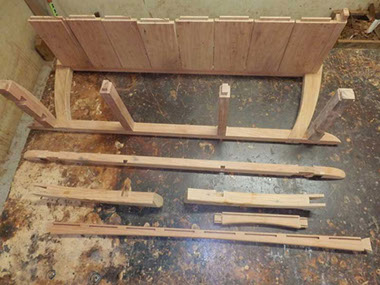
This picture of a bench under construction shows the large and varied amount of joints that are used in the crafting of a piece of our furniture.
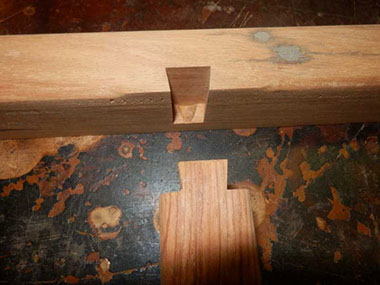
In the picture above, you can see a half dovetail joint that locks two rails together.
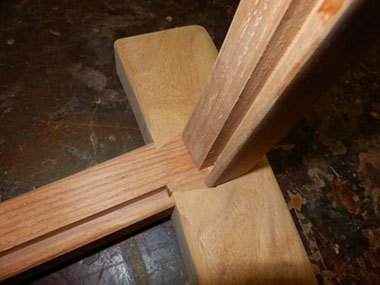
In this picture you can see a half dovetail that is also locked into position by a wedged tenon. The wedged tenon ensures that the two joints will not come apart. This how we can make furniture without nails.
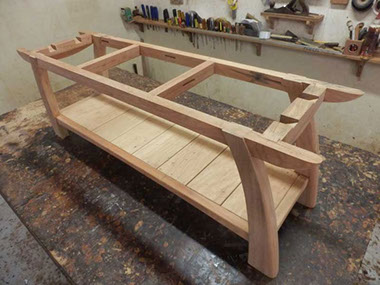
Before the piece is assembled, all pieces are sanded to very smooth finish. The final piece is then assembled as shown in the above picture.
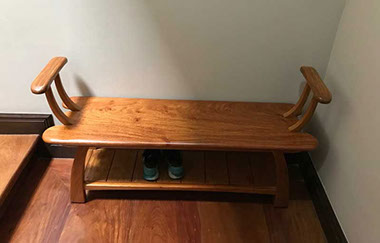
After assembly, the piece has a final sanding and then the chosen finish is applied. This finish can be either a lacquer or our own oil based finish. Both finishes then have 3 coats of beeswax polish applied before being released from the workshop. This type of finish enhances the look of the piece but more importantly, the life of the piece, as the beeswax helps to condition and preserve the wood.
All of our furniture is made using the traditional methods of furniture making that have evolved over hundreds of years. This includes mortise and tenon joints and drawers that have Dovetail Joints to name a few. We DO NOT use nails in the construction of our furniture.
Our furniture is crafted from recycled Philippine hard-woods. We do not use soft woods like Philippine Mahogany (Internationally called "Lauan", but can also be called "Meranti", or "Serai") as it is too soft and has the tendency to shrink and expand to much to make high quality long lasting furniture.
We do not get involved in mass production or copying mass produced furniture for clients. We will however take into account a design that you show us and make that into our interpretation and concept of the piece for you.
"We are what we repeatedly do. Excellence, then, is not an act, but a habit."
― Aristotle ―
Selective Restorations
Rustic Molave Table
Some other interesting Restorations
Restorations are something that we occasionally undertake. It is not our area of expertise and as such, we are selective in the type of pieces we accept for restoration.
When we do restoration work, it is normally a full restoration and not just a partial repair. Full restoration is expensive and very time consuming, so the prices for this are generally quite high. It is also very hard to determine what the cost of the restoration would be, so this is done on an estimate only basis.
All that said, we have and continue to repair unique pieces and pieces from Artists like Napoleon Abueva of which we have done many.
An example of the type of restoration we do is this (Below) easel made in Madrid, Spain, circa 1955. It was something that caught George's eye when he was asked about restoring it. It belonged to and was the main working easel of Lee Aguinaldo (Philippine Artist) and has too much history to be allowed to decay any further. A lot of the timber has been destroyed by borers and needs to be replaced along with other broken and missing components. It is difficult to match timbers that come from Spain with local recycled timbers that we use but it can be done.
Lee's wife Melba was happy to leave all the decisions about the restoration to George Coles our designer and master craftsman.
_00.jpg?crc=3859500983)
Before
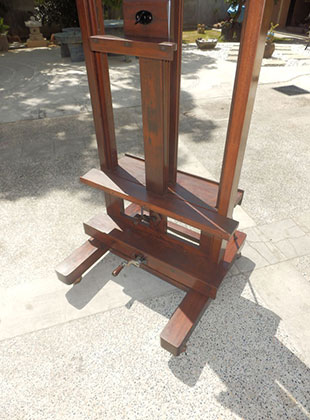
After
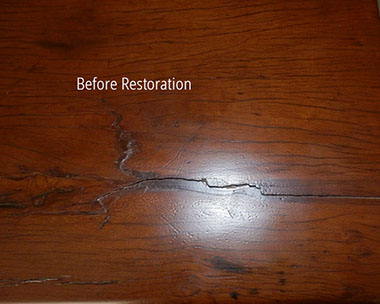
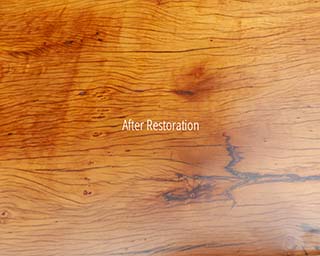
This table top is a very old Rustic Style. The owners did not want to hide the imperfections in the top and in fact where happy to keep them. What we did was to repair all the splits that were affecting the structural integrity of the table and then re-coat it. Notice the other features that now seem to pop out of the top. The previous finish was a varnish. We removed that and use our own oil based finish, which tends to bring the colors out more. Also and oil based finish is easier to repair if it gets damaged.
Kamagong Table
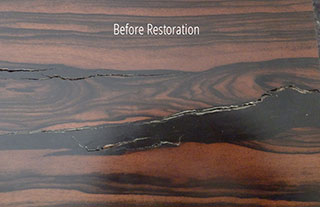
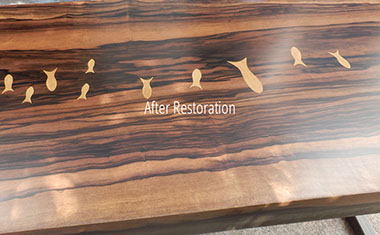
This table top is a slab of Kamagong. Sadly, it was cut through the center of the tree and contains the heart wood of the tree. Heart Wood always shrinks and expands at a different rate then the outer part of the tree. This being the case, the center section of the table will always show signs of checking (Splitting) After this checking occurs, the best way to remedy it is to put in the insets that are fixed on either side of the checks. Normally this is done with what are called butterflies or dovetails, see below, but I now like to use fish as they are more distinctive and perform the same function. Looking at this top, it may seem a large amount of fish to use, but as it is Heart wood and Kamagong, there are a lot of small checks that will continue to open larger if not stabilized. If it was not heart wood, we could have used far less fish.
Note: The use of the marine epoxy and stain that was used to hide this problem originally on the table top does not work well in the longer term and that is why the owner eventually came to Jarrah Works Fine Furniture for a solution.
Using Butterflies for Checks in Timber
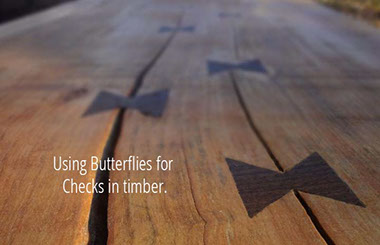
This is the traditional method that is used to repair checks (splitting in timber). They are called Butterflies as that is what they resemble most. It looks good as a feature and sometimes the checks are left open to enhance the look of the piece. This of course depends on the piece and the owners preferences.
Carved Panels
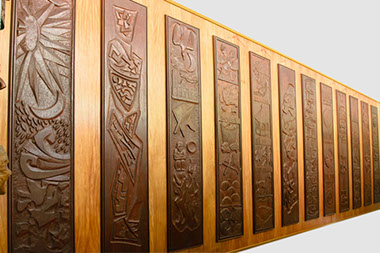
These panels were carved by Napoleon Abueva for his brother Pepe. They represent many of the places that Pepe taught as a Professor around the world. Several panels had checks and all were in need of refinishing. Afterwards, we mounted them on a large framed Narra panel which we fixed to the wall. Now visitors walk past the "Travels of Pepe and Corinne" when they enter the home.
You will never do anything in this world without courage. It is the greatest quality of the mind next to honor.
― Aristotle ―
We Purchase Old Furniture
We often find that many pieces of furniture we have had passed down to us or purchased earlier in our lives is now not needed or does not suit our decor. Often these pieces are stored away and left to the termites or borers to have fun with. Many of these pieces can still have a role to play as they can be re purposed into new furniture and start their life cycle again.
We at Jarrah Works Fine Furniture will always consider purchasing old furniture for re-purposing into new pieces. This old furniture needs to be made from old Philippine hard woods and preferably, larger pieces like tables etc.
Note: We do not buy pieces made from Philippine Mahogany as we do not use this timber in our furniture.
If you are interesting in selling these pieces to us for re-purposing, we ask that you:
- Take several pictures of the pieces or pieces from different angles.
- To send the photos and information to us Click Here
- Please tell us where the furniture is located and what the price is that you want for the pieces.
- We will then get back to you as to whether or not, the pieces would be suitable to us to re purpose. If they are, we will organize with you when would be the best time for us to pick up the pieces.
The use of old furniture is something we take pride in as this is a really good way to help the environment by not letting things go to waste or be burnt.
If you have old timber, we will also consider the purchase of it.



